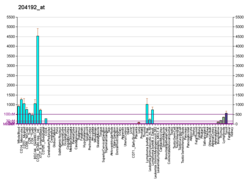CD37
| CD37 | |||||||||||||||||
|---|---|---|---|---|---|---|---|---|---|---|---|---|---|---|---|---|---|
| Identifiers | |||||||||||||||||
| Aliases | CD37, GP52-40, TSPAN26, CD37 molecule | ||||||||||||||||
| External IDs | OMIM: 151523 MGI: 88330 HomoloGene: 20422 GeneCards: CD37 | ||||||||||||||||
|
|||||||||||||||||
| RNA expression pattern | |||||||||||||||||
 |
|||||||||||||||||
| More reference expression data | |||||||||||||||||
| Orthologs | |||||||||||||||||
| Species | Human | Mouse | |||||||||||||||
| Entrez |
|
|
|||||||||||||||
| Ensembl |
|
|
|||||||||||||||
| UniProt |
|
|
|||||||||||||||
| RefSeq (mRNA) |
|
|
|||||||||||||||
| RefSeq (protein) |
|
|
|||||||||||||||
| Location (UCSC) | Chr 19: 49.34 – 49.34 Mb | Chr 7: 45.23 – 45.24 Mb | |||||||||||||||
| PubMed search | |||||||||||||||||
|
|
|||||||||||||||||
NM_007645
NM_001290802
NM_001290804
NP_001277731
NP_001277733
NP_031671
Leukocyte antigen CD37 is a protein that in humans is encoded by the CD37 gene.
The protein encoded by this gene is a member of the transmembrane 4 superfamily, also known as the tetraspanin family. Most of these members are cell-surface proteins that are characterized by the presence of four hydrophobic transmembrane domains. Tetraspanins mediate signal transduction events that play a role in the regulation of immune responses, cell development, activation, growth and motility. CD37 expression is restricted to cells of the immune system, with highest abundance on mature B cells, and lower expression is found on T cells and myeloid cells. CD37 is a cell surface glycoprotein that is known to complex with integrins and other transmembrane 4 superfamily proteins. Alternate splicing results in multiple transcript variants encoding different isoforms. CD37 controls both humoral and cellular immune responses. CD37-deficiency in mice leads to spontaneous development on B cell lymphoma, and patients with CD37-negative lymphomas have a worse clinical outcome.
...
Wikipedia
